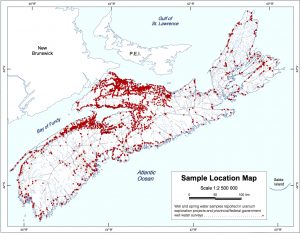Why Test for Radon Gas?
 Nova Scotia is a Uranium hotspot and where there is Uranium there is Radon Gas. Check out this quick read provided by Pillar to Post Home Inspections!
Nova Scotia is a Uranium hotspot and where there is Uranium there is Radon Gas. Check out this quick read provided by Pillar to Post Home Inspections!
Any home can have a radon gas problem – old or new homes, well-sealed or drafty homes, homes with or without basements. It is estimated that nearly 1 in 15 homes in the U.S. and Canada has an elevated level of radon gas. Prolonged exposure to unsafe levels of radon gas can create an increased risk of lung cancer; in fact, radon is the second leading cause of lung cancer after smoking. Lung cancer caused by avoidable radon exposure is preventable, but only if radon issues are detected and mitigated prior to prolonged exposure in homes and buildings. There is real risk in not knowing if a home has a high level of radon.
WHAT IS RADON?
Radon is a naturally occurring odorless, colorless, radioactive gas formed by the ongoing decay of uranium in soil, rocks, sediments, and even well or ground water. While radon that escapes into the atmosphere is not harmful, dangerously high concentrations can build up indoors, exposing residents to possible health risks.
HOW DOES RADON GET INTO A HOME?
Radon can migrate into the home in several ways. Openings or cracks in basement walls, foundations or floors are common avenues. Sumps, basement drains, and spaces between gas or water fittings can also allow radon into the structure. Other entry points can include gaps in suspended floors and cavities within walls.
HOW CAN I MAKE SURE MY FAMILY FAMILY IS NOT AT RISK?
I now always encourage home buyers to request that radon testing be added the home inspection process. Many Inspectors now provide this service as part of a home inspection or as a separate service, including Pillar To Post Home Inspections. They set up the monitoring equipment in the home and report on the results. If an elevated level of radon is detected, steps can be taken to reduce the concentration to or below acceptable levels inside virtually any home. This can include a relatively simple setup such as a collection system with a radon vent pipe, which prevents radon from entering the home in the first place. Professional mitigation services can provide recommendations for a home’s specific conditions.
If you are wondering about the likelihood of Radon gas in your neighbourhood, click on this interactive map. For more information on how you can include radon testing in conjunction with your home inspection or to request just this service, contact me for a list of qualified Home Inspectors. Alternatively, check with your local library. Many have a hand held tester you can borrow. However, the test kits Home Inspectors use are much more accurate. Also you can buy your very own test kit for about $40 from the Lung Association.

